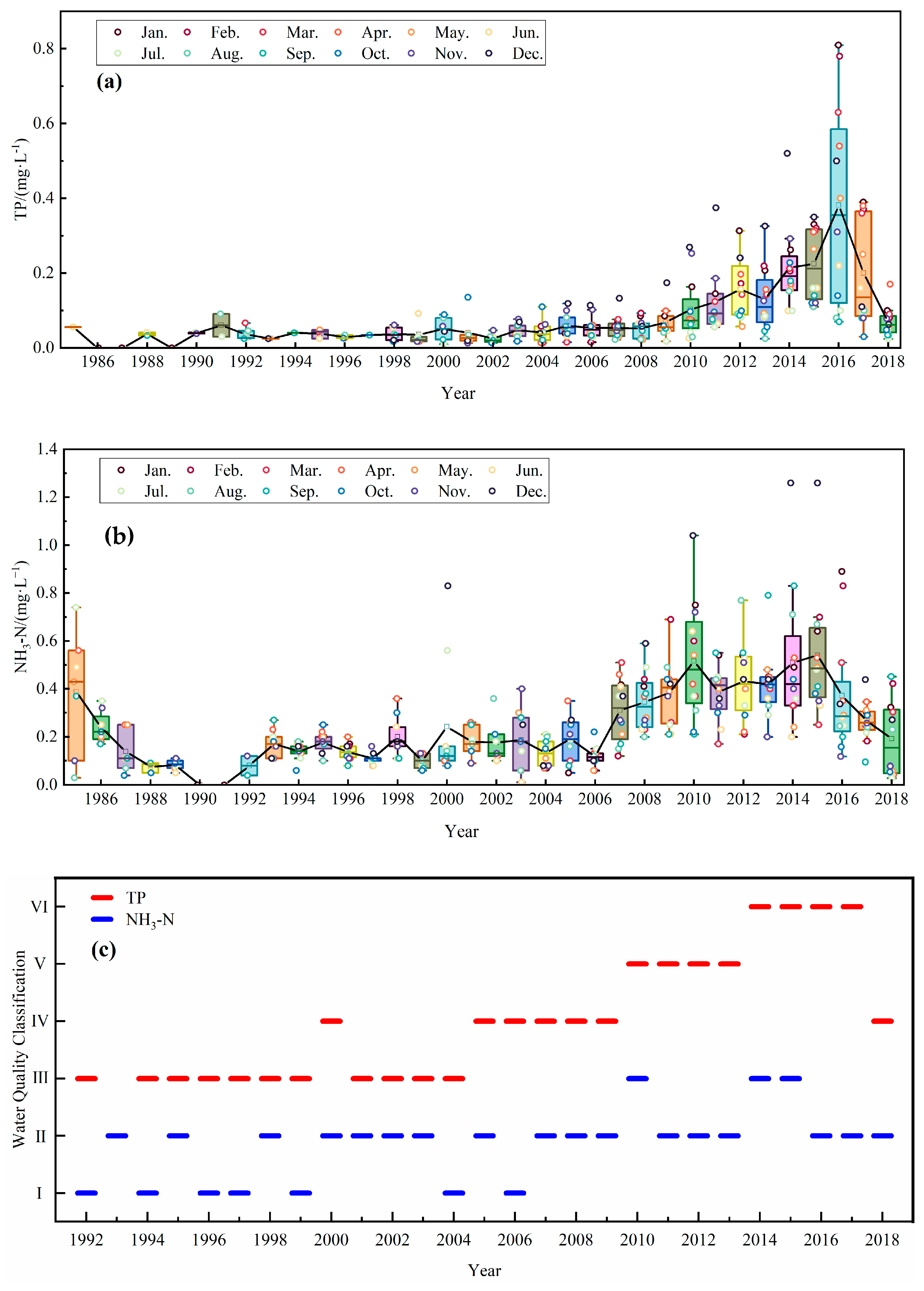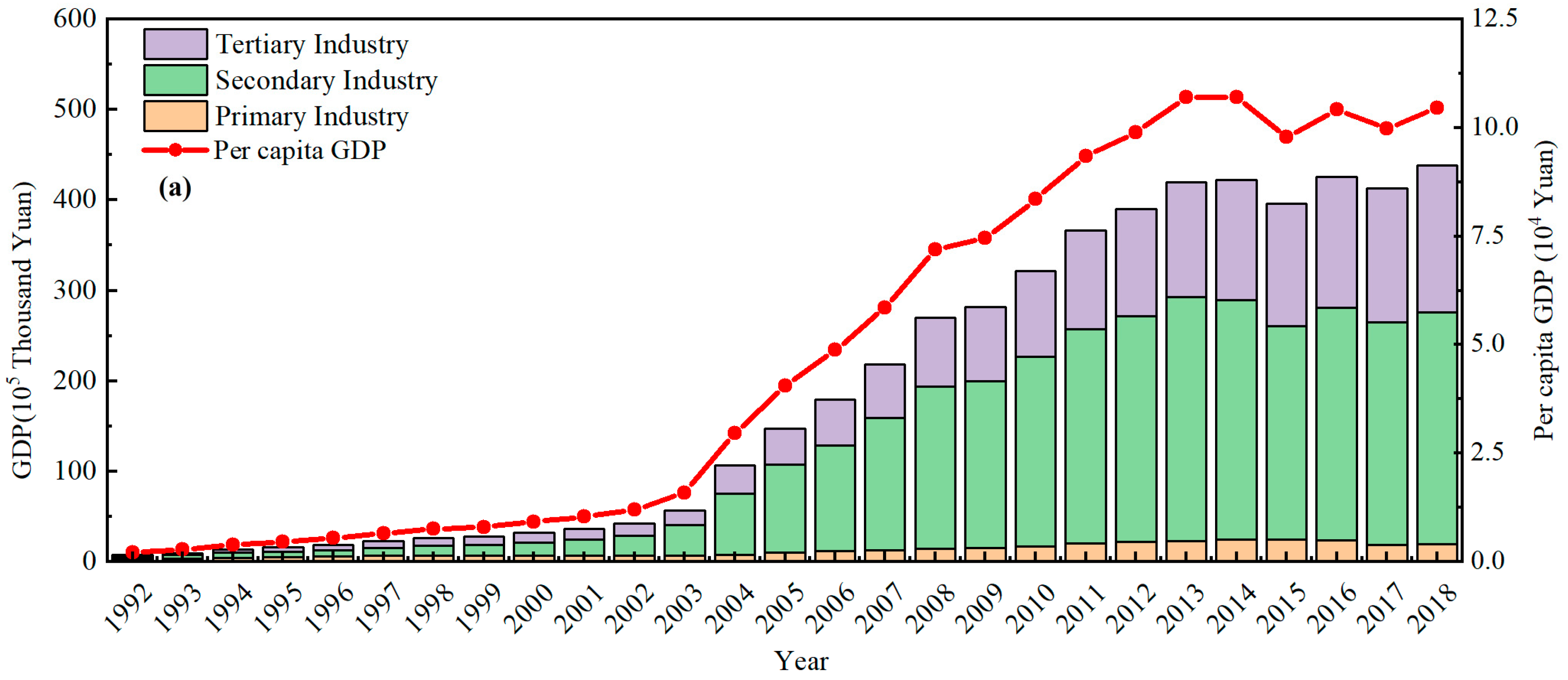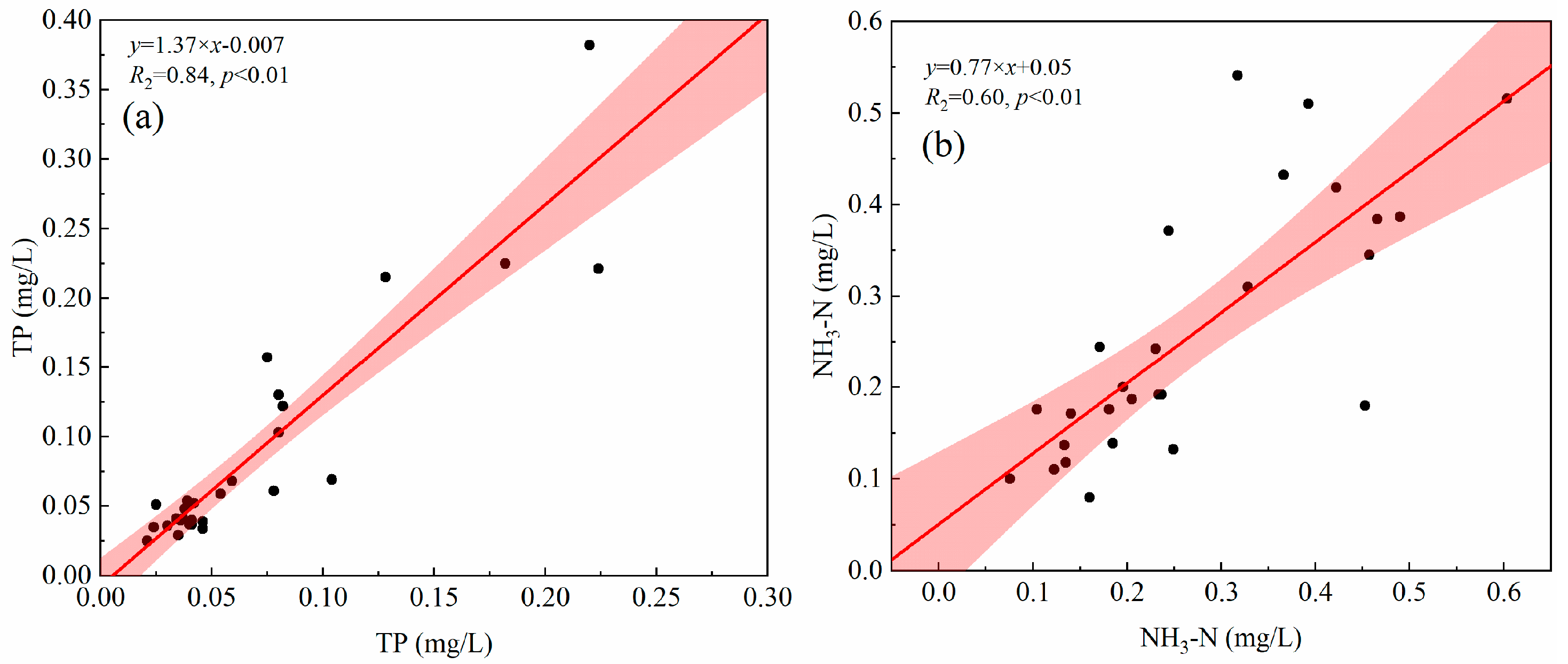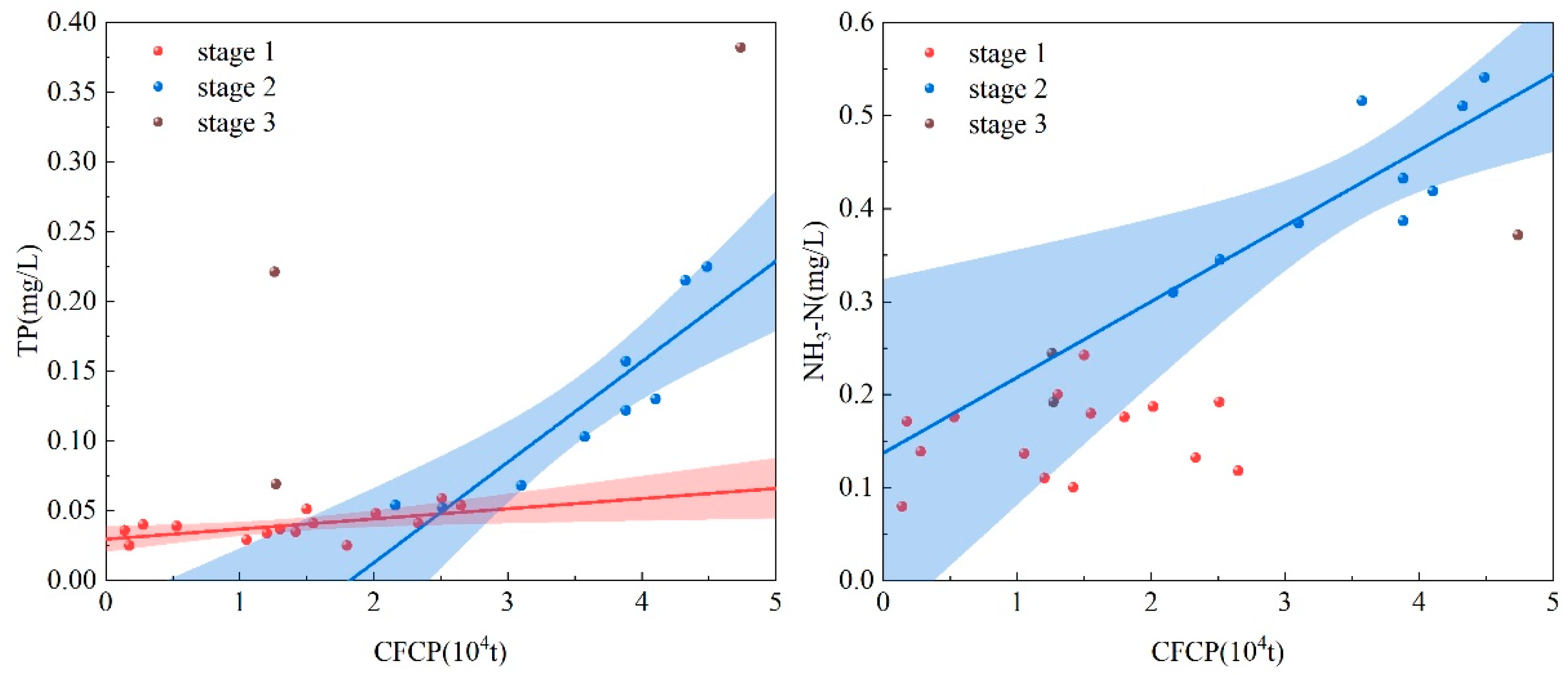Evolution Characteristics of Water Quality in Plain Reservoirs and Its Relationship with the Economic Development Response: A Case Study of Daheiting Reservoir in Northern China
Abstract
:1. Introduction
2. Materials and Methods
2.1. Study Area
2.2. Data Sources and Analysis
3. Results and Analysis
3.1. Analysis of Water Quality Change
3.1.1. Analysis of Annual Changes in Water Quality
3.1.2. Analysis of Monthly Changes in Water Quality
3.2. Analysis of Social and Economic Development Trends
3.2.1. Trend Analysis of GDP
3.2.2. Analysis of Cage Fish Culture Development Trend in Qianxi County
3.3. Effects of Upstream Water on Water Quality Change of Daheiting Reservoir
3.4. Effects of Cage-Fish Culture on Water Quality Changes in Daheiting Reservoir
4. Discussions
5. Conclusions
Author Contributions
Funding
Data Availability Statement
Acknowledgments
Conflicts of Interest
References
- Li, Z.; Ma, J.; Guo, J.; Paerl, H.W.; Brookes, J.D.; Xiao, Y.; Fang, F.; Ouyang, W.; Lunhui, L. Water quality trends in the Three Gorges Reservoir region before and after impoundment (1992–2016). Ecohydrol. Hydrobiol. 2019, 19, 317–327. [Google Scholar] [CrossRef]
- Shourian, M.; Moridi, A.; Kaveh, M. Modeling of eutrophication and strategies for improvement of water quality in reservoirs. Water Sci. Technol. 2016, 74, 1376–1385. [Google Scholar] [CrossRef]
- Yang, L.; Peng, S.; Zhao, X.; Li, X. Development of a two-dimensional eutrophication model in an urban lake (China) and the application of uncertainty analysis. Ecol. Model. 2017, 345, 63–74. [Google Scholar]
- Longyang, Q. Assessing the effects of climate change on water quality of plateau deep-water lake-A study case of Hongfeng Lake. Sci. Total Environ. 2019, 647, 1518–1530. [Google Scholar] [CrossRef] [PubMed]
- Grossman, G.M.; Krueger, A.B. Environmental Impacts of a North American Free Trade Agreement; National Bureau of Economic Research: Cambridge, MA, USA, 1991. [Google Scholar]
- Panayotou, T. Empirical Tests and Policy Analysis of Environmental Degradation at Different Stages of Economic Development; International Labour Office: Geneva, Switzerland, 1993. [Google Scholar]
- Paudel, K.P.; Zapata, H.; Susanto, D. An empirical test of environmental Kuznets curve for water pollution. Environ. Resour. Econ. 2005, 31, 325–348. [Google Scholar] [CrossRef]
- Lee, C.C.; Chiu, Y.B.; Sun, C.H. The environmental Kuznets curve hypothesis for water pollution: Do regions matter? Energy Policy 2010, 38, 12–23. [Google Scholar] [CrossRef]
- Thompson, A. Environmental Kuznets curve for water pollution: The case of border countries. Mod. Econ. 2014, 5, 66–69. [Google Scholar] [CrossRef]
- Tenaw, D.; Beyene, A.D. Environmental sustainability and economic development in sub-Saharan Africa: A modified EKC hypothesis. Renew. Sustain. Energy Rev. 2021, 143, 110897. [Google Scholar] [CrossRef]
- Al Sayed, A.; Sek, S.K. Environmental Kuznets curve: Evidences from developed and developing economies. Appl. Math. Sci. 2013, 7, 1081–1092. [Google Scholar] [CrossRef]
- Özokcu, S.; Özdemir, Ö. Economic growth, energy, and environmental Kuznets curve. Renew. Sustain. Energy Rev. 2017, 72, 639–647. [Google Scholar] [CrossRef]
- Ongan, S.; Isik, C.; Ozdemir, D. Economic growth and environmental degradation: Evidence from the US case environmental Kuznets curve hypothesis with application of decomposition. J. Environ. Econ. Policy 2021, 10, 14–21. [Google Scholar] [CrossRef]
- Wei, M.; Huang, S.; Li, L.; Zhang, T.; Akram, W.; Khatoon, Z.; Renaud, F.G. Evolution of water quality and biota in the Panjiakou Reservoir, China as a consequence of social and economic development: Implications for synergies and trade-offs between Sustainable Development Goals. Sustain. Sci. 2021, 17, 1385–1404. [Google Scholar] [CrossRef]
- Liu, C.; Wang, S.; Liu, X.; Zhou, H.; Li, B.; Du, Y.; Wang, L. Characteristics of water quality response to hypolimnetic anoxia in Daheiting Reservoir. Water Sci. Technol. 2022, 85, 2065–2075. [Google Scholar] [CrossRef]
- Yang, W.; Yao, J.; He, Y.; Huang, Y.; Liu, H.; Zhi, Y.; Qian, S.; Yan, X.; Jian, S.; Li, W. Nitrogen removal enhanced by benthic bioturbation coupled with biofilm formation: A new strategy to alleviate freshwater eutrophication. J. Environ. Manag. 2021, 292, 112814. [Google Scholar] [CrossRef] [PubMed]
- Smith, V.H.; Tilman, G.D.; Nekola, J.C. Eutrophication: Impacts of excess nutrient inputs on freshwater, marine, and terrestrial ecosystems. Environ. Pollut. 1999, 100, 179–196. [Google Scholar] [CrossRef]
- Nürnberg, G.K. Trophic state of clear and colored, soft-and hardwater lakes with special consideration of nutrients, anoxia, phytoplankton and fish. Lake Reserv. Manag. 1996, 12, 432–447. [Google Scholar] [CrossRef]
- Dodds, W.K.; Jones, J.R.; Welch, E.B. Suggested classification of stream trophic state: Distributions of temperate stream types by chlorophyll, total nitrogen, and phosphorus. Water Res. 1998, 32, 1455–1462. [Google Scholar] [CrossRef]
- Håkanson, L. A Review on Effect-Dose-Sensitivity Models for Aquatic Ecosystems. Int. Rev. Gesamten Hydrobiol. Hydrogr. 1994, 79, 621–667. [Google Scholar] [CrossRef]
- Jing, C.; Su, B.D.; Zhai, J.Q.; Wang, Y.J.; Lin, Q.G.; Gao, M.N.; Jiang, S.; Chen, Z.Y.; Jiang, T. Gridded value-added of primary, secondary and tertiary industries in China under Shard Socioeconomic Pathways. Sci. Data 2022, 9, 309. [Google Scholar] [CrossRef]
- Kang, G.; Yin, J.; Cui, N.; Ding, H.; Wang, S.; Wang, Y.; Qi, Z. The long-term and retention impacts of the intervention policy for cage aquaculture on the reservoir water qualities in Northern China. Water 2020, 12, 3325. [Google Scholar] [CrossRef]
- Domagalski, J.; Lin, C.; Luo, Y.; Kang, J.; Wang, S.; Brown, L.R.; Munn, M.D. Eutrophication study at the Panjiakou-Daheiting Reservoir system, northern Hebei Province, People’s Republic of China: Chlorophyll-a model and sources of phosphorus and nitrogen. Agric. Water Manag. 2007, 94, 43–53. [Google Scholar] [CrossRef]
- Liu, C.; Liu, X.; Zhou, H.; Li, B.; Wang, S.; Wang, L. Study on the threshold condition to suppress anoxic zone by large flow operation process. J. Hydraul. Eng. 2021, 52, 1217–1228. [Google Scholar] [CrossRef]
- Liu, C.; Liu, X.; Zhou, H.; Wang, S.; Li, B. Temporal and spatial evolution characteristics and driving factors of reservoir anoxic zone. J. Hydraul. Eng. 2019, 50, 1479–1490. [Google Scholar] [CrossRef]
- Geletu, T.T. Lake eutrophication: Control of phytoplankton overgrowth and invasive aquatic weeds. Lakes Reserv. Res. Manag. 2023, 28, e12425. [Google Scholar] [CrossRef]
- Tumolo, B.B.; Flinn, M.B. Diet of invasive silver carp (Hypophthalmichthys molitrix) in a mainstem reservoir ecosystem. J. Ky. Acad. Sci. 2019, 79, 3–11. [Google Scholar]
- Huang, S.; Wu, M.; Zang, C.; Du, S.; Domagalski, J.; Gajewska, M.; Gao, F.; Lin, C.; Guo, Y.; Liu, B. Dynamics of algae growth and nutrients in experimental enclosures culturing bighead carp and common carp: Phosphorus dynamics. Int. J. Sediment Res. 2016, 31, 173–180. [Google Scholar] [CrossRef]
- Hargreaves, J.A. Nitrogen biogeochemistry of aquaculture ponds. Aquaculture 1998, 166, 181–212. [Google Scholar] [CrossRef]
- Wu, M.; Huang, S.; Zang, C.; DU, S. Enclosure experimental research with fish culturing in the Panjiakou ReservoirⅡ.Effects of fish food and fish species on phosphorus flux. J. Hydraul. Eng. 2013, 44, 1204–1209. [Google Scholar] [CrossRef]












| Water Quality Factor | Stage | Curve Fitting | R2 | p |
|---|---|---|---|---|
| TP | Stage Ⅰ | y = 7.28 × 10−3 × x + 0.03 | 0.36 | <0.05 |
| Stage Ⅱ | y = 0.07 × x − 0.13 | 0.81 | <0.01 | |
| Stage Ⅲ | - | - | - | |
| NH3-N | Stage Ⅰ | - | - | - |
| Stage Ⅱ | y = 0.08 × x + 0.14 | 0.67 | <0.01 | |
| Stage Ⅲ | - | - | - |
Disclaimer/Publisher’s Note: The statements, opinions and data contained in all publications are solely those of the individual author(s) and contributor(s) and not of MDPI and/or the editor(s). MDPI and/or the editor(s) disclaim responsibility for any injury to people or property resulting from any ideas, methods, instructions or products referred to in the content. |
© 2023 by the authors. Licensee MDPI, Basel, Switzerland. This article is an open access article distributed under the terms and conditions of the Creative Commons Attribution (CC BY) license (https://creativecommons.org/licenses/by/4.0/).
Share and Cite
Li, B.; Chen, K.; Liu, X.; Liu, C.; Wang, S. Evolution Characteristics of Water Quality in Plain Reservoirs and Its Relationship with the Economic Development Response: A Case Study of Daheiting Reservoir in Northern China. Water 2023, 15, 3229. https://doi.org/10.3390/w15183229
Li B, Chen K, Liu X, Liu C, Wang S. Evolution Characteristics of Water Quality in Plain Reservoirs and Its Relationship with the Economic Development Response: A Case Study of Daheiting Reservoir in Northern China. Water. 2023; 15(18):3229. https://doi.org/10.3390/w15183229
Chicago/Turabian StyleLi, Budong, Kaiqi Chen, Xiaobo Liu, Chang Liu, and Shiyan Wang. 2023. "Evolution Characteristics of Water Quality in Plain Reservoirs and Its Relationship with the Economic Development Response: A Case Study of Daheiting Reservoir in Northern China" Water 15, no. 18: 3229. https://doi.org/10.3390/w15183229
APA StyleLi, B., Chen, K., Liu, X., Liu, C., & Wang, S. (2023). Evolution Characteristics of Water Quality in Plain Reservoirs and Its Relationship with the Economic Development Response: A Case Study of Daheiting Reservoir in Northern China. Water, 15(18), 3229. https://doi.org/10.3390/w15183229







